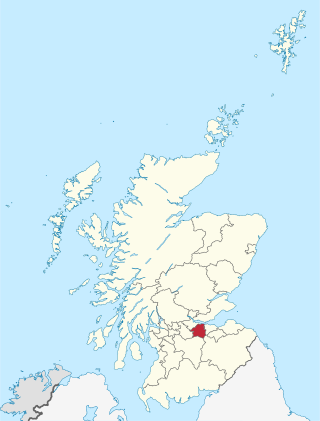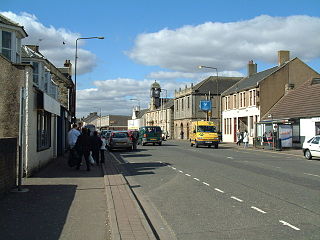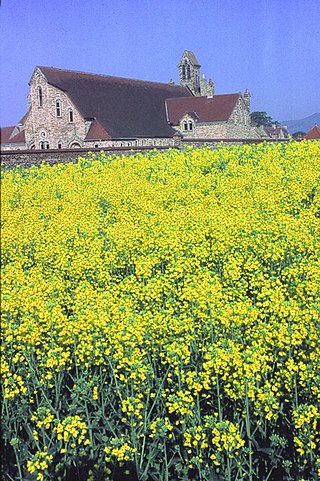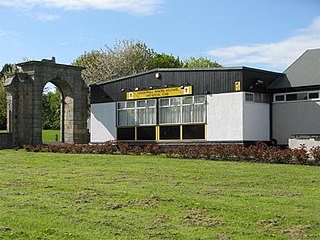
Midlothian is a historic county, registration county, lieutenancy area and one of 32 council areas of Scotland used for local government. Midlothian lies in the east-central Lowlands, bordering the City of Edinburgh council area, East Lothian and the Scottish Borders.

West Lothian is one of the 32 council areas of Scotland, and was one of its historic counties. The county was called Linlithgowshire until 1925. The historic county was bounded geographically by the Avon to the west and the Almond to the east. The modern council area occupies a larger area than the historic county. It was reshaped following local government reforms in 1975: some areas in the west were transferred to Falkirk; some areas in the east were transferred to Edinburgh; and some areas that had formerly been part of Midlothian were added to West Lothian.
Bonnyrigg is a town in Midlothian, Scotland, which is eight miles southeast of Edinburgh city centre, between the Rivers North and South Esk. The town had a population of 14,663 in the 2001 census which rose to 15,677 in the 2011 census, both figures based on the 2010 definition of the locality which, as well as Bonnyrigg and the adjacent settlement of Lasswade, includes Polton village, Poltonhall housing estate and modern development at Hopefield. The estimated population for 2018 is 18,120, the highest of any town in Midlothian. Along with Lasswade, Bonnyrigg is a twin town with Saint-Cyr-l'École, France.

Tranent is a town in East Lothian, in the south-east of Scotland. The town lies 6 miles from the boundary of Edinburgh, and 9.1 miles from the city centre. It lies beside the A1 road, the A1 runs through the parish splitting the parish from its associated villages and hamlets namely Meadowmill and the port of the parish Cockenzie. The original main post road ran straight through the town until the new A1 was built. Built on a gentle slope, about 90 metres (300 ft) above sea level it is one of the oldest towns in East Lothian. The population of the town is approximately 12,140, an increase of over 4,000 since 2001. Tranent was formerly a major mining town, but now serves as a commuter town for Edinburgh.

Gorebridge is a former mining village in Midlothian, Scotland.

Whitburn is a small town in West Lothian, Scotland, halfway between Scotlands's two largest cities, about 23 miles east of Glasgow and 22 miles west of Edinburgh. The nearest major towns are Bathgate, four miles and Livingston, six miles.

Harthill is a rural village split between North Lanarkshire and West Lothian in Scotland, with most of the village in North Lanarkshire. It is located about halfway between Glasgow, 21 miles to the west, and Edinburgh, 25 miles (40 km) to the east. It lies on the River Almond about 2+1⁄2 miles (4 km) west of the small town of Whitburn. The closest major towns are Bathgate, 6 miles (9.7 km) away, and Livingston, 10 miles (16 km) away. Major towns within North Lanarkshire, such as Wishaw, Airdrie, Motherwell, Coatbridge and Bellshill are all around 10 to 15 miles to the west. The M8 motorway bypasses the village and Harthill has a service station named after it.

Lasswade is a village and civil parish in Midlothian, Scotland, on the River North Esk, nine miles south of Edinburgh city centre, contiguous with Bonnyrigg and between Dalkeith to the east and Loanhead to the west. Melville Castle lies to the north east. The Gaelic form is Leas Bhaid, meaning the "clump at the fort."

Mayfield is a community in Midlothian, Scotland, located just south of Dalkeith near Edinburgh between the A68 and the A7 south. It had an estimated population of 13,690 in 2020.

Newtongrange is a former mining village in Midlothian, Scotland. Known in local dialect as Nitten, or Nitten by the Bing , it became Scotland's largest mining village in the 1890s, with the sinking of the Lady Victoria Colliery and a shaft over 1600 feet deep. This closed in 1981 but today houses the National Mining Museum, an Anchor Point of ERIH - The European Route of Industrial Heritage.

Rosewell is a former mining village in Midlothian, Scotland, east of Roslin and south-west of Bonnyrigg. The village is in the civil parish of Lasswade and was previously a separate ecclesiastical parish, but has its own Community Council, namely Rosewell and District.

Danderhall is a village in Midlothian, Scotland, just outside Edinburgh but inside the Edinburgh City Bypass.

Bilston is a small village in Midlothian, Scotland. It is located on the edge of Edinburgh, just south of Loanhead on the A701. The Bilston Burn Site of Special Scientific Interest (SSSI) was occupied from 2002 until the mid-2010s by protestors who successfully opposed plans for a bypass.

Edgehead is a village in Midlothian, Scotland.

Viewpark is an area in North Lanarkshire, Scotland. Situated immediately north-east of Uddingston, Viewpark is two kilometres west of Bellshill. It has an estimated population of 13,916 in 2016, a figure which also includes the smaller adjoining neighbourhoods of Birkenshaw, Bellziehill, Calderbraes, Fallside and Tannochside under the Thorniewood ward of the local council.

The Midlothian Coalfield is a coalfield in southeast Scotland situated immediately to the east and southeast of Edinburgh. It is geologically continuous with the East Fife Coalfield beneath the Firth of Forth though the undersea coal reserves have only been partly exploited. There were undersea workings extending from Prestonlinks Colliery. The sulphur content of the majority of Midlothian coals is less than 1% making it especially suitable for modern requirements.
The Edinburgh, Loanhead and Roslin Railway was a railway line south of Edinburgh, Scotland, built primarily to serve mineral workings, although passenger trains were operated. It is also known as the Glencorse Branch of the North British Railway. It opened from a junction at Millerhill on the Waverley Route, to Roslin in 1874 and was extended to a location near Penicuik to serve Glencorse Barracks and a colliery in 1877 and to Penicuik Gas Works in 1878.
The Esk Valley Railway was a short branch line built to serve industry in the valley of the River North Esk, south of Edinburgh in Scotland. The terminus was Polton. The line opened on 15 April 1867
Ernest Arthur Oliphant Auldjo Jamieson FRIBA MID (1880–1937) was a Scottish architect operating in the early 20th century. He specialised in country houses, largely for wealthy family friends. From after the First World War he also got many commissions from local authorities for social housing, plus several commissions related to hospitals and asylums.
















